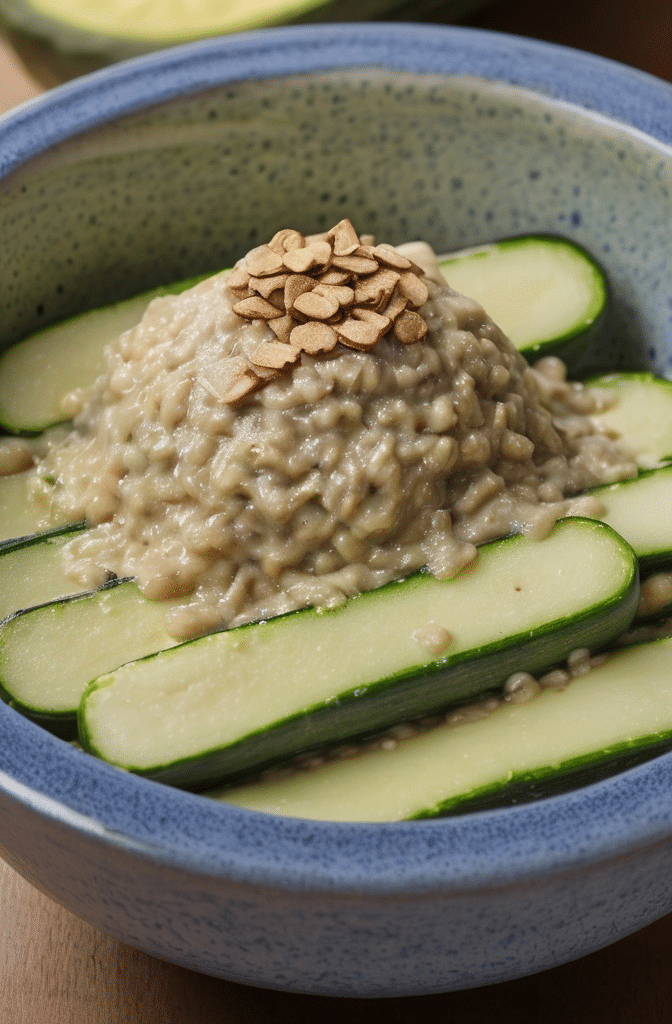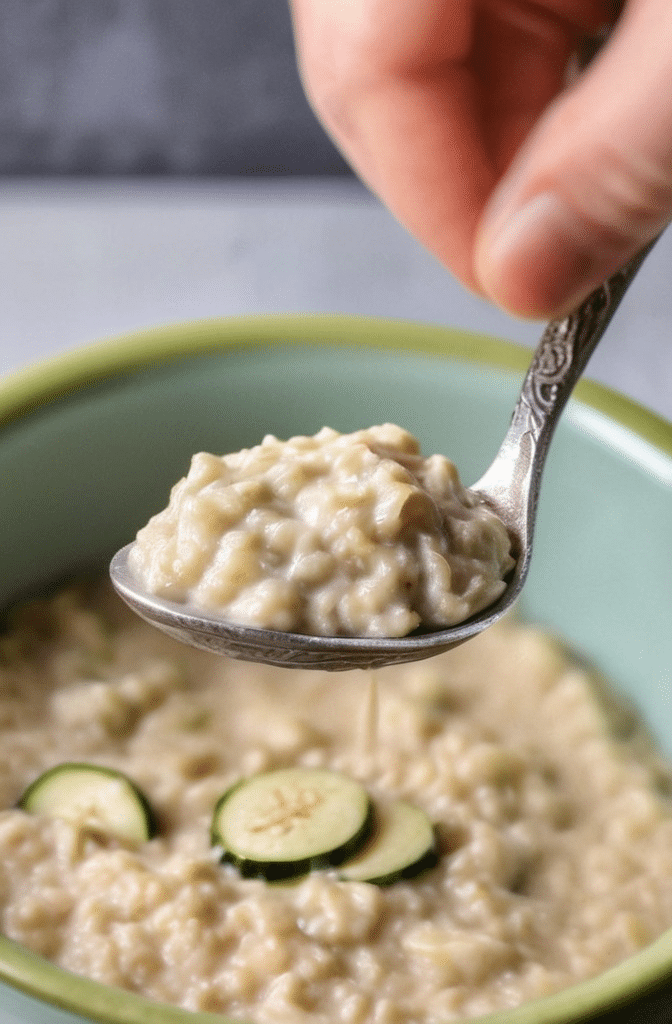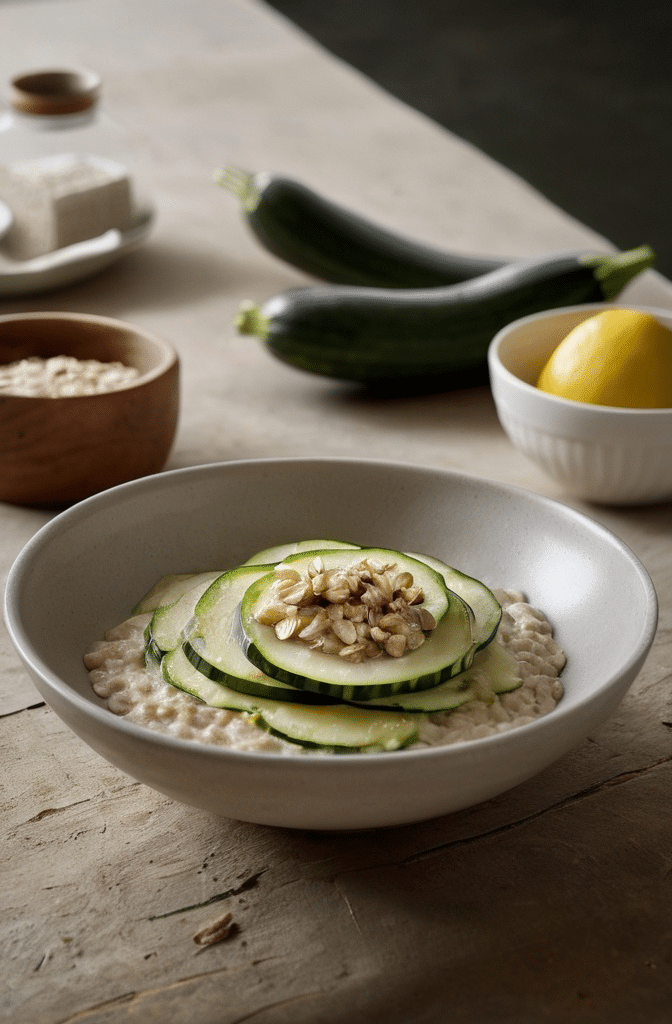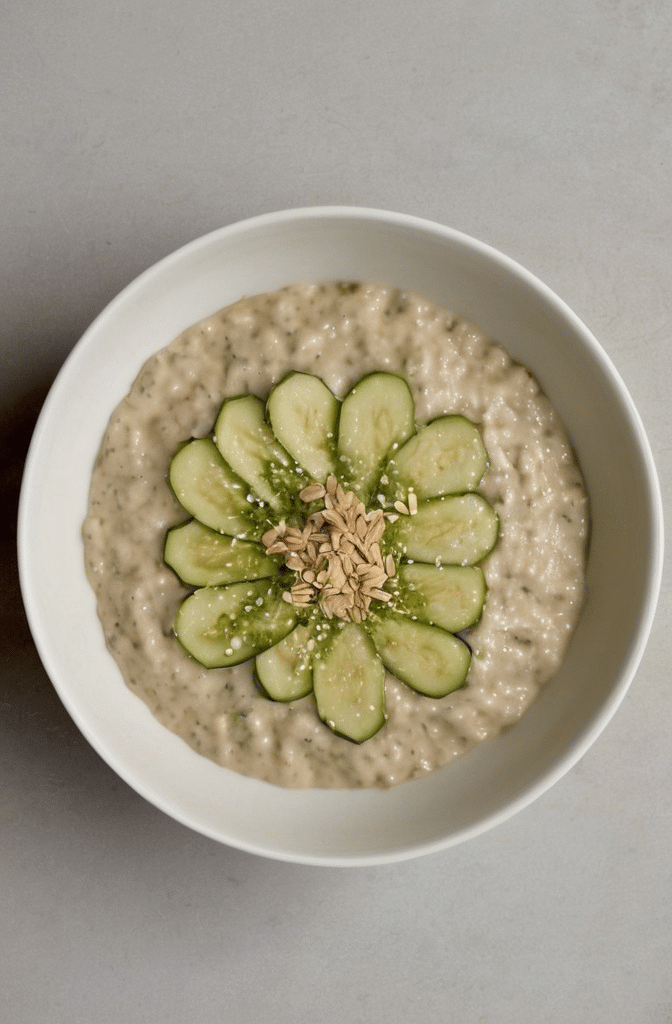The first time I encountered zucchini mixed with oatmeal, I nearly spit out my coffee. It was at a small farm-to-table restaurant in Portland, where the chef—renowned for her eccentric pairings—served me what looked like a traditional bowl of morning oats. But hidden within was shredded zucchini that added a surprising freshness and nutritional boost. That single bite changed my entire perspective on these humble ingredients. Who’d of thought these two ordinary pantry staples could create such culinary magic when brought together?
Zucchini with oatmeal represents one of those rare culinary innovations that crosses traditional boundaries—blurring the lines between breakfast, lunch, dinner, and dessert. This versatile combination leverages the subtle flavor profile of zucchini with the hearty texture of oats to create dishes that are nutritionally dense yet remarkably adaptable. What makes this pairing truly special is its chameleon-like ability to transform into sweet or savory preparations, depending entirely on your mood or dietary needs.
The Nutritional Powerhouse Behind the Pairing
Lemme tell you something about nutrition that might surprise you. When zucchini meets oatmeal, you’re witnessing a nutritional symphony in action. Zucchini brings its impressive water content (about 95%), making it one of the most hydrating vegetables available, while delivering vitamins A, C, and potassium with minimal calories. Oats counter with their exceptional fiber content—particularly beta-glucan fiber—which has been shown to reduce cholesterol levels and improve heart health.
Together, they create a dish with remarkable staying power. The soluble fiber from oats slows digestion, while zucchini adds volume without significantly increasing caloric intake. This combination helps maintain stable blood sugar levels and provides sustained energy throughout the day. For athletes and fitness enthusiasts, its an ideal recovery meal, offering complex carbohydrates alongside vegetables that aid hydration.
The micronutrient profile deserves special attention too. Zucchini contains lutein and zeaxanthin—carotenoids that support eye health—while oats provide manganese, phosphorus, magnesium, and iron. Combined, they deliver a spectrum of antioxidants that fight inflammation and support cellular health.
1. Ingredients & Substitutions

For Basic Zucchini Oatmeal (Serves 2)
- 1 cup rolled oats (not quick oats or steel-cut)
- 2 cups liquid (water, milk, plant-based milk, or a combination)
- 1 medium zucchini (about 1 cup when grated)
- ¼ teaspoon salt
- 1 tablespoon maple syrup, honey, or your preferred sweetener (optional)
- ½ teaspoon vanilla extract (for sweet versions)
- ½ teaspoon cinnamon (optional)
- 1 tablespoon butter or coconut oil (optional)
The choice of oats matters tremendously here. Rolled oats (sometimes labeled as old-fashioned oats) provide the ideal texture—they hold their shape while absorbing liquid beautifully. Quick oats can work in a pinch, but they’ll create a mushier final product. Steel-cut oats require significantly longer cooking times and more liquid, requiring recipe adjustments. If your going gluten-free, ensure your oats are certified gluten-free, as cross-contamination can occur during processing.
Zucchini selection deserves careful consideration. Medium-sized zucchini offer the best flavor—baby zucchini can be too delicate and watery, while oversized specimens often develop bitter notes and tough seeds. The dark green skin contains much of the nutritional value, so avoid peeling unless absolutely necessary. Yellow summer squash can substitute perfectly, providing a slightly sweeter profile and vibrant color variation.
For liquid components, dairy milk creates the creamiest texture, but almond milk offers a lighter alternative with subtle nutty notes. Coconut milk makes for an indulgently tropical variation, particularly excellent in dessert applications. Oat milk provides additional oat flavor, intensifying the dish’s earthy qualities. Water works perfectly well if you’re looking to highlight the clean flavors of the zucchini.
2. Step-by-Step Instructions

Sweet Breakfast Zucchini Oatmeal
- Prepare your zucchini by washing thoroughly, trimming the ends, and grating on the medium holes of a box grater. A critical step many cooks miss: after grating, place the zucchini in a clean kitchen towel and squeeze gently to remove excess moisture—this prevents soggy oatmeal while retaining all the nutritional benefits.
- In a medium saucepan over medium heat, combine your oats and liquid of choice (milk creates a creamier result than water). Bring to a gentle simmer, stirring occasionally to prevent sticking. The most common mistake here is using too high heat, which can cause the milk to scorch and the oats to cook unevenly.
- When the oats have absorbed about half the liquid (approximately 2-3 minutes), fold in the grated zucchini, salt, and cinnamon if using. Continue cooking for another 3-4 minutes until the oatmeal reaches your preferred consistency. Pro tip: for extra creaminess, stir constantly during the final minutes of cooking to release more starch from the oats.
- Remove from heat and stir in your sweetener and vanilla. Let stand for 2 minutes before serving—this resting period allows the oatmeal to thicken slightly and flavors to meld. For an indulgent touch, top with a small pat of butter that melts lusciously into the hot cereal.
The texture should be creamy but still have some definition to the oats. If its too thick, simply add a splash more liquid and stir. For meal prep convenience, this base recipe can be refrigerated for up to 3 days and reheated with additional liquid to restore its creamy consistency.
Savory Zucchini Oatmeal Bowl
- Follow steps 1-2 from the sweet version, but omit cinnamon and sweeteners. Instead, add ¼ teaspoon each of garlic powder and dried thyme when adding the zucchini.
- During the final minute of cooking, fold in 2 tablespoons of grated parmesan cheese and freshly cracked black pepper. The residual heat will melt the cheese without overcooking it.
- Serve topped with a poached or fried egg, additional fresh herbs (chives and basil work wonderfully), and a drizzle of extra virgin olive oil. The runny yolk creates a luxurious sauce when stirred into the oatmeal.
For variations, consider adding quick-cooking vegetables like spinach or cherry tomatoes during the final minute of cooking. Leftover roasted vegetables can be folded in just before serving to add textural contrast and additional flavor dimensions.
3. Cooking Techniques & Science
The marriage of zucchini and oatmeal succeeds largely because of how these ingredients interact on a molecular level. Oats release starch slowly during cooking, creating that characteristic creamy texture we associate with porridge. When zucchini is introduced, its high water content becomes trapped within this starch matrix, preventing the dish from becoming watery while maintaining moisture.

The cooking temperature plays a crucial role in developing flavor. A gentle simmer (rather than a rolling boil) allows the zucchini to release its subtle flavors without developing the sulfurous notes that can emerge when brassicas and squashes are overcooked. This gentle heat also prevents the oats from breaking down completely, maintaining that desired balance between creamy and textured.
For those interested in the Maillard reaction—that beautiful browning process that creates deep flavor—try this chef’s technique: after preparing basic zucchini oatmeal, spread a portion in a hot, buttered skillet and allow it to develop a crispy crust before folding it back into the remaining oatmeal. This creates pockets of concentrated flavor and textural contrast that elevate the entire dish.
The grating technique impacts the final product significantly. A fine grate makes the zucchini nearly disappear into the oatmeal—ideal for picky eaters or when smoothness is desired. A coarser grate creates noticeable green flecks and more textural variation. For maximum nutritional value, include the skin in your grating, as it contains much of the zucchini’s fiber and antioxidants.
4. Serving & Pairing Suggestions

Sweet Applications
Zucchini oatmeal in its sweet form pairs beautifully with seasonal fruits that complement its delicate flavor. In summer, fresh berries or stone fruits add brightness, while autumn calls for sautéed apples or pears with warming spices. Textural contrast elevates the experience—consider toasted nuts, crunchy granola clusters, or cacao nibs sprinkled generously on top.
For a cafe-worthy presentation, serve in a wide, shallow bowl that showcases colorful toppings. Create a “topping bar” with yogurt, nut butters, seeds, fruits, and sweeteners when serving guests, allowing each person to customize their bowl. A light dusting of cinnamon or raw cacao powder adds visual appeal and aromatic elements.
The beverage pairing shouldnt be overlooked. A tart kombucha or cold-pressed green juice provides refreshing contrast to sweet zucchini oatmeal. For coffee drinkers, light-to-medium roasts with fruity notes complement rather than overwhelm the subtle zucchini flavor.
Savory Applications
As a savory dish, zucchini oatmeal functions brilliantly as a grain alternative to risotto or polenta. Top with roasted vegetables, braised meats, or seafood for a complete meal. The neutral canvas takes well to global flavor profiles—try Mediterranean-inspired toppings like roasted red peppers, olives, and feta, or explore Asian flavors with soy-glazed mushrooms, scallions, and sesame seeds.
Wine pairings should consider the toppings, but generally, a crisp white with good acidity like Sauvignon Blanc or unoaked Chardonnay complements the earthy elements of the dish. For heartier preparations with meat, a light-bodied red like Pinot Noir works surprisingly well.
For family-style service, consider a “zucchini oatmeal bar” where the base is prepared simply and guests can choose from an array of toppings—similar to a congee or grits bar setup in modern restaurants. This interactive approach makes for an engaging dining experience while accommodating various dietary preferences.
Advanced Culinary Applications
Beyond basic preparations, zucchini oatmeal transforms into numerous sophisticated applications. Cooled and shaped into patties, it can be pan-seared to create fritters with crispy exteriors and creamy centers—ideal vehicles for toppings like avocado, pickled onions, or herb-forward yogurt sauces.
The same mixture, with slight modifications to reduce moisture, makes an excellent binding agent for vegetarian burgers or croquettes. The neutral flavor profile allows bold seasoning while the oats provide structure and the zucchini ensures moistness.
In baking, zucchini oatmeal can be incorporated into quick breads, muffins, and breakfast cookies. The combination provides natural sweetness while reducing the need for added fats and refined flours. These baked goods retain moisture exceptionally well, extending shelf life compared to conventional recipes.
Perhaps most surprisingly, chilled zucchini oatmeal forms the basis for an exceptional summer soup when blended with avocado, herbs, and a touch of acid from lemon or yogurt. Served cold with a swirl of quality olive oil, it becomes an elegant first course that showcases seasonal produce at its peak.
Cultural Significance and Global Interpretations
While this specific combination might seem modern, cultures worldwide have long paired grains with summer squashes. In Greek cuisine, kolokithopita combines zucchini with grains in savory pies. Mexican calabacitas often include corn—a grain cousin to our oats—alongside zucchini in comforting stews.
Middle Eastern traditions feature bulgur wheat with zucchini in stuffed vegetables and hearty salads. Each culture recognizes the nutritional complementarity and textural benefits of combining tender summer squash with sturdy grains.
Today’s interest in zucchini oatmeal reflects broader culinary trends: the blurring of meal categories (breakfast foods appearing at dinner), increased emphasis on plant-forward eating, and creative approaches to incorporating more vegetables into everyday meals.
Conclusion
Zucchini with oatmeal represents far more than a clever pairing—it embodies culinary innovation that doesn’t sacrifice nutrition for flavor. The combination demonstrates how humble ingredients, thoughtfully prepared, can create dishes of remarkable versatility and satisfaction.
Whether youre exploring it as a morning ritual, a post-workout refuel, or the foundation for elaborate culinary creations, zucchini oatmeal rewards experimentation. The basic technique, once mastered, opens doors to endless variations that adapt to seasonal availability, dietary requirements, and flavor preferences.
What makes this pairing truly exceptional is its accessibility. Both ingredients are inexpensive, widely available, and require minimal cooking skills to prepare successfully. Yet the results can be nuanced enough to impress even discerning palates.
As our understanding of nutrition evolves and plant-forward eating becomes increasingly important, combinations like zucchini and oatmeal remind us that delicious, satisfying food need not be complicated. Sometimes, the most revolutionary culinary ideas are simply new perspectives on familiar ingredients.
Frequently Asked Questions?
Can I use frozen zucchini in oatmeal?
Yes, frozen zucchini can work, but requires special handling. Thaw completely, then squeeze thoroughly to remove excess moisture—more aggressively than with fresh zucchini. The texture will be slightly softer, making it better suited for applications where zucchini is meant to “disappear” into the dish rather than provide textural contrast.
How can I increase the protein content of zucchini oatmeal?
Several excellent options exist. Stirring in Greek yogurt after cooking adds creaminess alongside protein. Adding a scoop of unflavored or complementary-flavored protein powder works well—just increase liquid slightly to compensate. For savory versions, eggs (either stirred in while hot to create a custard-like effect or served on top) dramatically boost protein content. Plant-based alternatives include hemp hearts, which add 10g of protein per 3 tablespoons with minimal flavor impact.
Can zucchini oatmeal be prepared using overnight oats method?
Absolutely! Combine rolled oats with liquid of choice, then add finely grated zucchini, sweetener if desired, and flavorings. The key difference: refrigerate in individual containers without cooking. By morning, the oats will have softened and the zucchini will have gently “cured” in the mixture. This method works particularly well in warmer months when hot breakfast isn’t appealing. The texture will be chewier than cooked versions, with more pronounced zucchini presence.
How do I make zucchini oatmeal kid-friendly?
The secret lies in preparation and presentation. Use a fine grater so zucchini pieces are barely detectable. Consider peeling the zucchini first to remove the green skin if color is a concern. Emphasize sweet elements—cinnamon, vanilla, and familiar toppings like peanut butter, chocolate chips, or fruit preserve swirls. Name it something appealing, like “Power Oats” or “Green Machine Breakfast.” For many children, involvement in preparation increases willingness to try new foods, so letting kids customize their toppings can increase acceptance.

Veronica is a passionate food enthusiast with over three years of experience in exploring and writing about diverse cuisines. Her expertise lies in reviewing restaurants, sharing creative recipes, and discovering the latest food trends. As the voice behind FoodieRecap.com, Anju brings fresh perspectives and culinary insights to her audience.
